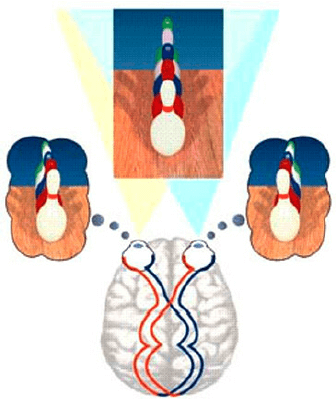Services
The Prevalence of Visual-Perceptual Delays with Sensory Integration Dysfunction
It comes as no surprise that children with Sensory Integration Dysfunction often experience visual-perceptual delays. Visual-perceptual skills encompass the capacity to interpret, analyze, and derive meaning from visual stimuli. Remarkably, over 70 percent of students deemed as ‘underachievers’ in the classroom encounter challenges in processing visual information, regardless of their 20/20 eyesight.


Visual discrimination is a crucial ability that empowers a child to recognize and distinguish various characteristics of objects, including their color, shape, size, and orientation. This skill plays a pivotal role in their capacity to sort and categorize objects effectively. As a child develops, their visual discrimination skills allow them to differentiate between fundamental shapes like triangles and circles, or uppercase and lowercase letters such as ‘B’ and ‘b.’ However, a child facing challenges with visual discrimination may struggle with tasks like identifying faces or discerning the distinctions between a rectangle and a square.
Visual attention is the ability of a child to remain focused on a task while filtering out distractions. A child prone to frequent distractions may find it challenging to sustain their visual attention. For instance, when reading, they might be compelled to divert their gaze towards any visual stimuli in their surroundings instead of concentrating solely on the words they should be reading. Some children struggle with shifting their visual attention efficiently, hindering their ability to absorb information effectively. Additionally, they may be unaware of events happening around them. A child with a low level of visual responsiveness may encounter difficulties in noticing visual cues or maintaining interest, often experiencing fatigue quickly. Children who struggle to pay visual attention can miss out on crucial developmental opportunities because they may not fully engage with and process the information in their environment.
Visual memory, on the other hand, is the skill that enables a child to retain and recall images they have seen. This skill is essential for tasks such as mimicking new gestures and movements, sequencing writing and spelling activities, recognizing words and individuals, among others. Children with poor visual memory might excel at remembering life experiences but struggle with retaining factual information. Consequently, they may encounter difficulties in connecting new visual information with their existing knowledge.
Figure-ground perception is the ability of a child to distinguish objects or elements in the foreground from the background, which is vital for maintaining focus on important visual stimuli without getting distracted by the surrounding environment. 
Visual closure is a crucial skill that allows a child to recognize objects or words even when they’re only partially visible, using visual cues to complete the missing information. For instance, this ability enables them to spot a lunchbox partially hidden behind a milk carton or decipher a whole word from just a portion of it, a proficiency that skilled readers often demonstrate without scrutinizing every letter.
Form constancy is another essential skill that enables a child to perceive objects as identical regardless of changes in their environment, orientation, size, or other details. For example, a child can identify a spoon as a spoon regardless of its position (upside down or sideways) or its material (whether it’s a silver tablespoon or a plastic toy spoon). In an educational context, this skill allows a child to recognize that the letter ‘S’ remains the same whether it’s handwritten or typed, in print or cursive, or oriented differently.
Laterality, directionality, and spatial vision: Laterality is the ability of a child to distinguish between the right and left sides of their own body, while directionality enables them to perceive the right and left sides of external objects. Both of these skills are fundamental to spatial vision, which helps a child understand how objects are positioned in space. For instance, thanks to these skills, a child can differentiate between lowercase ‘b,’ which has a line on the left side, and ‘d,’ which has a line on the right side. A child with poor spatial vision may encounter difficulties in playing with toys, mastering tasks like climbing stairs or catching a ball (both of which require depth perception), and developing essential self-care abilities. Such difficulties can manifest as persistent letter reversals (beyond the age of eight), confusion regarding letter or number sequences, challenges in comprehending directional language like up, down, in, out, under, and over, and a struggle with topographical orientation, often resulting in getting lost easily.
Furthermore, a child must also nurture their visual-motor integration skills, which involve the harmonious coordination of their eyes and body to accomplish various developmental tasks, ranging from stringing beads to catching a ball. These skills, commonly referred to as eye-hand coordination, encompass the interaction of motor skills, visual perceptual abilities, and visual processing skills.
WE UNDERSTAND THAT YOU MIGHT HAVE A NUMBER OF QUESTIONS, ESPECIALLY IF THIS IS THE FIRST TIME YOU HAVE EXPERIENCED ANY EYE PROBLEMS.
FEEL FREE TO CONTACT OUR OFFICE – NEURO VISION THERAPY CENTER AND OUR BEHAVIORAL AND DEVELOPMENTAL OPTOMETRISTS WILL BE READY TO ASSIST YOU WITH YOUR VISION CONCERNS.
REFERENCE:
Biel, L., & Peske, N. K. (2005). Raising a sensory smart child: the definitive handbook for helping your child with sensory integration issues. New York: Penguin Books.)
